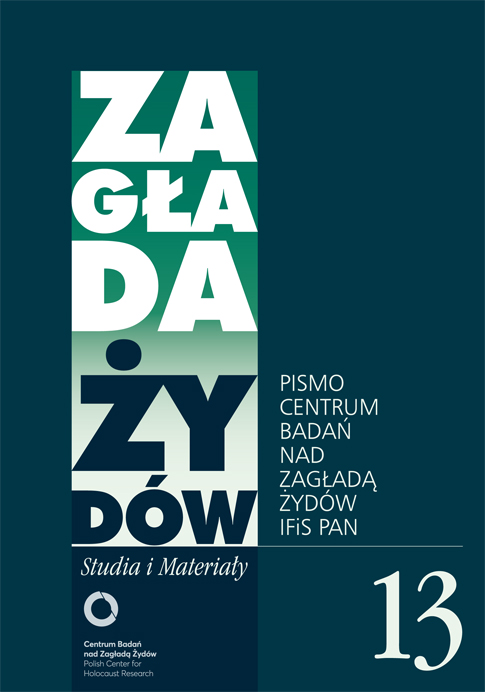Bernard Mark, powstanie w getcie warszawskim i proces Jürgena Stroopa
Zagłada Żydów. Studia i Materiały, Nr 13 (2017), Strony: 181-202
Data zgłoszenia: 2020-10-17Data publikacji: 2017-12-03
 https://doi.org/10.32927/ZZSiM.356
https://doi.org/10.32927/ZZSiM.356
Abstrakt
Jürgen Stroop, the SS general who led the liquidation of the Warsaw Ghetto and the suppression of the Warsaw Ghetto Uprising in April–May 1943, was convicted by a Polish court in 1951 and executed in 1952. Bernard (Ber) Mark (1908–1966), Holocaust historian and director of the Jewish Historical Institute in Warsaw, provided expert testimony for the prosecution at Stroop’s trial. Mark felt constrained to graft a communist-inflected narrative onto his account of the Warsaw Ghetto Uprising and to shoehorn it into his expert testimony in court and then into his interpretation of the trial for a Jewish audience. He did his best to give the Jewish Fighting Organization, which spearheaded the uprising, and its Jewish fighters their due at a time when expression of unvarnished appreciation for Jewish heroism was risky, even while he was paying overrated tribute to the communist underground for its assistance to the Jewish rebels during the uprising. But he always stopped short of the line between conformity to and defiance of the communist regime
Słowa kluczowe
Bernard Mark , Żydowski Instytut Historyczny , powstanie w getcie warszawskim , proces Jürgena Stroopa
Licencja
Prawa autorskie (c) 2017 Autor&"Zagłada Żydów. Studia i Materiały"

Utwór dostępny jest na licencji Creative Commons Uznanie autorstwa 4.0 Międzynarodowe.
https://creativecommons.org/licenses/by/4.0
Czasopismo publikowane jest w standardzie Diamond Open Access na licencji CC-BY-4.0 Deed - Uznanie autorstwa 4.0 Międzynarodowa - Creative Commons
Inne teksty tego samego autora
- Gabriel Finder, Proces Szepsla Rotholca a polityka kary w następstwie Zagłady , Zagłada Żydów. Studia i Materiały: Nr 2 (2006)
- Gabriel Finder, Svenja Bethke, Dance on the Razor’s Edge:Crime and Punishment in the Nazi Ghettos [Gabriel N. Finder] , Zagłada Żydów. Studia i Materiały: Nr 17 (2021)
Podobne artykuły
- Andrzej Żbikowski, Texts Buried in Oblivion. Testimonies of Two Refugees from the Mass Grave at Poniatowa , Zagłada Żydów. Studia i Materiały: 2008: Holocaust Studies and Materials
- Zofia Wóycicka, Laboratorium zagłady – nowa ekspozycja historyczna na terenie obozu zagłady Kulmhof w Chełmnie nad Nerem , Zagłada Żydów. Studia i Materiały: Nr 16 (2020)
- Aleksandra Bańkowska, Polish Partisan Formations during 1942–1944 in Jewish Testimonies , Zagłada Żydów. Studia i Materiały: 2008: Holocaust Studies and Materials
- Justyna Majewska, Krystyna Radziszewska, Ewa Wiatr, Adam Sitarek, Jacek Walicki, Monika Polit (red.), Encyklopedia getta. Niedokończony projekt archiwistów z getta łódzkiego , Zagłada Żydów. Studia i Materiały: Nr 11 (2015)
- Barbara Engelking, Tajemnica Hesi. Zapis emocji w świadectwach Zagłady , Zagłada Żydów. Studia i Materiały: Nr 10 (2014)
- Joanna Nalewajko-Kulikov, Gunnar S. Paulsson, Secret City: the Hidden Jews of Warsaw 1940-1945 , Zagłada Żydów. Studia i Materiały: Nr 1 (2005)
- Eleonora Bergman, Archiwum Ringelbluma w 36 tomach - refleksje , Zagłada Żydów. Studia i Materiały: Nr 20 (2024)
- Andrzej Żbikowski, Goetz Aly, Hitlers Volksstaat. Raub, Rassenkrieg und nationaler Sozialismus , Zagłada Żydów. Studia i Materiały: Nr 1 (2005)
- Marcin Zaremba, “That load of Jews is finally dead.” Extermination of Jews as presented in 1942 letters of German soldiers , Zagłada Żydów. Studia i Materiały: Nr Holocaust Studies and Materials (2017)
- Barbara Engelking, Żydzi i komuniści w okupowanej Warszawie , Zagłada Żydów. Studia i Materiały: Nr 14 (2018)
<< < 1 2 3 4 5 6 7 8 9 10 11 12 13 14 15 16 17 18 19 20 21 22 23 24 25 26 27 28 29 30 31 32 33 34 35 36 37 38 39 40 41 42 43 44 45 46 47 48 > >>
Możesz również Rozpocznij zaawansowane wyszukiwanie podobieństw dla tego artykułu.
 English
English
 Język Polski
Język Polski



 https://orcid.org/0000-0003-2829-3979
https://orcid.org/0000-0003-2829-3979

